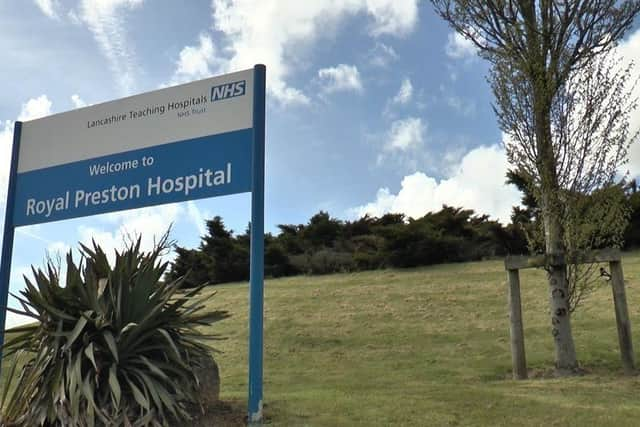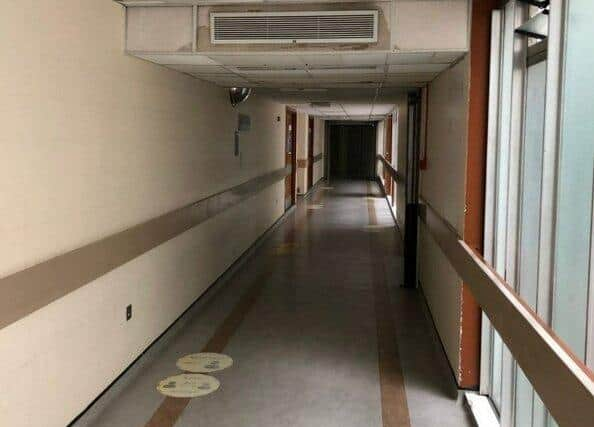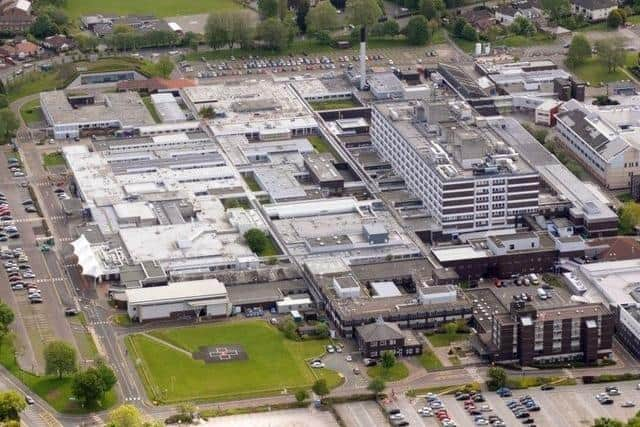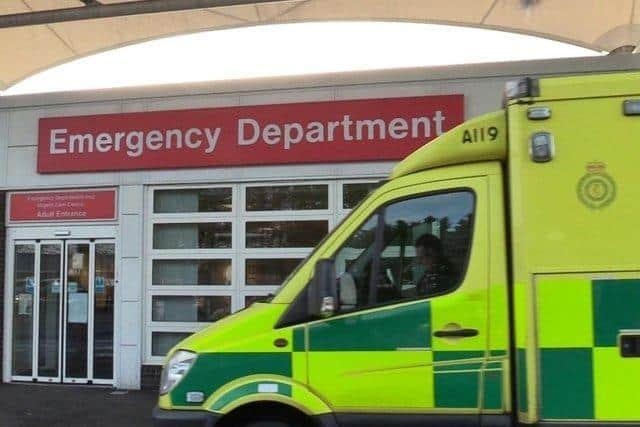Royal Preston Hospital to be replaced with new building on a different site - but not until the 2030s
and live on Freeview channel 276
Unexpected confirmation of the new facilities to replace the Royal Preston Hospital and Royal Lancaster Infirmary - on new sites elsewhere - came in the wake of confusion following a government announcement outlining the next steps for its nationwide New Hospitals Programme.
Regional NHS leaders last year made an ambitious bid for the cash needed to fund two state-of-the-art centres serving both cities.
Advertisement
Hide AdAdvertisement
Hide AdThat was the preferred option championed on a shortlist of four possibilities that was finalised last September - almost two years after the Preston and Lancaster sites were named as one of the 40 “new hospital” schemes that the government had pledged to build by 2030.


In an announcement in the Commons on Thursday afternoon, health secretary Steve Barclay declared that all of the previously-announced projects would proceed - but he identified the Lancashire and South Cumbria region’s proposal as one of eight whose completion date would be pushed back beyond the end of this decade.
He did not specifically state whether the government backed the blueprint for two new hospitals or the trio of other options that were put on the table by local NHS chiefs as a cheaper plan B - namely, the partial rebuilds of both sites or a new hospital for either Preston or Lancaster and the extensive refurbishment of the other.
However, Mr. Barclay did make reference to plans to “reconfigure services across two trusts” and, with a nod to Commons Speaker and Chorley MP Sir Lindsay Hoyle - who was not in the chamber at the time - said that “one of those sites…is expected to be near Chorley”.


Advertisement
Hide AdAdvertisement
Hide AdThat strongly suggested that the Royal Preston, at least, was in line for a new build and - after what the Lancashire Post understands was a hastily arranged meeting of regional NHS leaders and local hospital trust bosses - the Lancashire and South Cumbria New Hospitals Programme went public with the fact that the green light had been given to rebuild both the Royal Preston and Royal Lancaster.
A search for land within a 10-mile radius of the exiting Preston and Lancaster hospitals has been ongoing since last year. The Post can reveal that the focus for the new Royal Preston has been on finding a location to the south of its current Sharoe Green Lane home.
One or more suitable site options for each city will be included for public consideration as part of the formal consultation that will be required before the building of the two new hospitals - deemed to be a major change to services - could be finally signed off.
There is no confirmed timeframe for that process, but there is less urgency to it now that the new facilities are not expected to be welcoming their first patients until the 2030s.


Advertisement
Hide AdAdvertisement
Hide AdWhile the health secretary did not specify how long into the next decade it would be before schemes like that for Lancashire and South Cumbria were completed, the Post understands that the window is expected to be between 2030-2035. He said that work on the delayed projects would now begin “over the next two years”.
“But they will be part of a rolling programme where not all work will be completed by 2030,” Mr. Barclay added.
The hold-up is a result of five other hospitals being drawn into the programme - and prioritised for complete rebuilds - after they were deemed to be in a dangerous condition as a result of the type of concrete used to construct them, which puts elements of the structures at risk of collapse after the end of the material’s lifespan.
Meanwhile, Steve Barclay's comments about reconfiguration in Lancashire appeared to hint at a shake-up of services at Chorley and South Ribble Hospital, if the new Royal Preston were to be built closer to the district facility than it is now.


Advertisement
Hide AdAdvertisement
Hide AdHowever, Jerry Hawker - senior responsible officer for the Lancashire and South Cumbria New Hospitals Programme - stressed to the Post that “no decisions on reconfigurations [have been taken] yet”.
“But clearly, as we progress towards the new build, we will be engaging with the public and with our staff as to the best configuration of services given [a new Royal Preston],” Mr. Hawker added.
Back in January 2020, after several years of false starts, a public consultation was about to be launched into the future of Chorley Hospital. The shortlist of options that was due to be put to the public was based on the replacement of the part-time A&E facility with some version of an urgent care centre, after the emergency department was branded unviable. The Euxton Lane site was slated to become a ringfenced unit for pre-planned surgery.
However, the pandemic put the brakes on the process and, in February 2021, then health secretary Matt Hancock ordered that it be scrapped altogether until a new consultation option was included that would have allowed for the retention of the A&E.
Advertisement
Hide AdAdvertisement
Hide AdThe need for wholly new hospitals for both Preston and Lancaster was hammered home in a “case for change” document designed to persuade the government to open its chequebook to fund them. That paper revealed a litany of issues facing both of the existing sites which made the futures of each perilous.
It warned that the majority of the facilities at the Royal Preston were experiencing “serious delipidation”, with buildings and, consequently, services at risk of failure.


At the Royal Lancaster, half of the estate was assessed as requiring demolition, while specific complications connected to the Ashton Lane plot - first used as a hospital in 1896 - were also highlighted, not least that ambulances are often required to ferry poorly patients from one part of the slopey site to another, at a cost half a million pounds a year.
The Preston and Lancaster facilities also have a maintenance backlog of £157m and £88m respectively - although much of that is still likely to need attention now that it will be so long until the replacement buildings come on stream.
Advertisement
Hide AdAdvertisement
Hide AdThe plan is for at least 70 percent of the rooms in the two new hospitals to be ensuite.
The so-called “super hospital” option - for a building that would likely have been located somewhere north of Preston and south of Lancaster - was dropped from a longlist of 10 possible permutations drawn up locally after public feedback suggested that it did not have popular support.
The Post understands that a visit to Lancashire by the national New Hospitals Programme team is being planned for the coming weeks.
The Lancashire and South Cumbria scheme was in the fourth of four “cohorts” within the nationwide programme, placing it amongst the largest and most complex schemes.
Advertisement
Hide AdAdvertisement
Hide AdA capital budget is yet to be allocated for the Royal Preston and Royal Lancaster replacements from within the “over £20bn” that Steve Barclay announced on Thursday was now expected to be the total investment across the country. However, the Health Service Journal reported in April that it would cost £35bn to build all of the promised facilities. Until this week, only £3.7bn had been confirmed to fund the earliest projects on the list.
The National Audit Office last year announced that it would be carrying out a value-for-money inquiry into the scheme, which is due to report later this year.
‘PATIENTS WILL GET THE ABSOLUTE BEST’
In a statement after confirmation of the new builds for Preston and Lancaster, Kevin McGee, chief executive of Lancashire Teaching Hospitals NHS Foundation Trust, which runs the Royal Preston and Chorley hospitals, said that creating new facilities on new sites would be “truly transformational ”.
“This is great news - and we are excited by the opportunities our New Hospitals Programme represents for the people of Lancashire and South Cumbria. Although the timing has changed, we welcome having clarity on both the timescales and the funding involved.
Advertisement
Hide AdAdvertisement
Hide Ad“[This will give] us the freedom to design our services and facilities around the needs of our patients, future-proofing services for the next generation,” Mr. McGee added.
Jerry Hawker, senior responsible officer for the Lancashire and South Cumbria New Hospitals Programme – who previously told the Post that wholly new facilities offered “the chance to do everything right for the first time” - said that the government announcement “brings our plans to offer the absolute best in modern healthcare and address significant problems with the current ageing hospital buildings a step closer”.
“We look forward to working closely with the national New Hospital Programme team to determine the specific allocation of funding for Lancashire and South Cumbria so that we can understand what this means for our local communities.”
Aaron Cummins, chief executive of University Hospitals of Morecambe Bay NHS Foundation Trust, which runs the Royal Lancaster Infirmary and Furness General - which will also see improvements funded - said: “This once-in-a-generation opportunity will be a huge contribution to our recovery as a health and care system after Covid-19, bringing new facilities and much needed investment into our patch for the benefit of patients and colleagues.”
LANCASHIRE’S PLEA TO MAKE HOSPITALS BETTER
Advertisement
Hide AdAdvertisement
Hide AdThese were some of the challenges facing the acute facilities in Preston and Lancaster which convinced the government of the need to start from scatch.
‘Royal Preston on the brink’
***The condition of the facilities has reached a critical stage and, without investment, buildings and services could fail.
***More than 70 percent of clinical facilities date from the 1970s to the 1990s and are experiencing “serious dilapidation”.
***80 percent of the site requires redevelopment or demolition over the medium to long term.
Advertisement
Hide AdAdvertisement
Hide Ad***Operating theatre capacity is 40 percent below the standard expected for newly built hospitals.
***Almost all operating theatres and all day case theatres are well below the recommended sizes, which are designed to enhance flexibility and enable new technology to be accommodated when it becomes available.
***Single room provision is available for just 19 percent of patients, compared to the 50 percent standard for new facilities.
***Inadequate car parking, which forces 1,000 staff to park off-site and use a park and ride.
‘Royal Lancaster patients need ambulances to get about’
Advertisement
Hide AdAdvertisement
Hide Ad***Much of the current site is located on a slope, which in some areas is too steep for patients to be safely moved except by ambulance.
***Access is particularly challenging for people with a disability.
***Some of the 20 buildings that make up the hospital are separated from the main complex by public highways and several services are provided in temporary buildings offering poor quality accommodation.
***Almost 20 percent of the current hospital estate dates back to the first half the last century.
Advertisement
Hide AdAdvertisement
Hide Ad***A&E attendances are running at 60,000 a year – half as many again as the 40,000 intended capacity.
***Running costs are double those of a new-build hospital.
***Single room provision is only half of the recommended standard and less than a third of the local ambition for 70 percent of patients to have single rooms.
***Inadequate car parking with just 460 spaces for more than 2,500 staff.
Source: Case for Change, Lancashire and South Cumbria NHS
